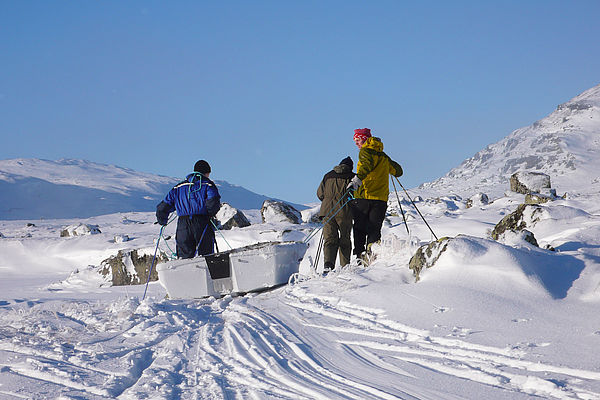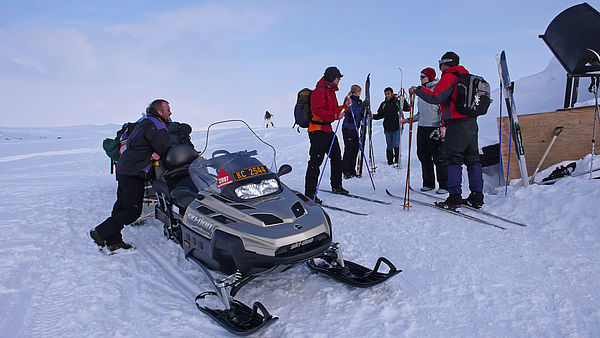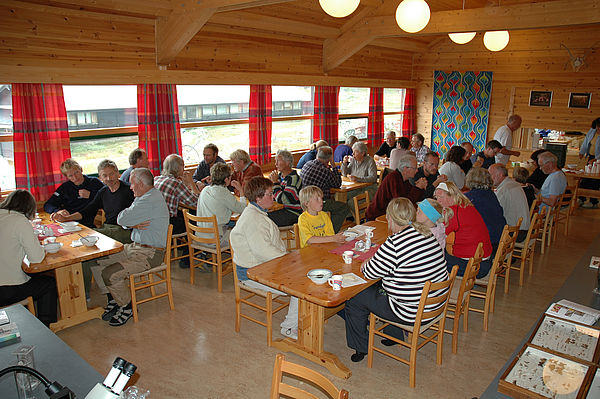
Background
IN0102 | |
Finse Alpine Research Centre | |
Arctic | |
Open | |
Station | |
Norway | |
Station | |
1965 | |
Year-Round |
Introduction
Finse Alpine Research Centre is owned by the Faculty of Mathematics and Natural Sciences of the University of Oslo, Norway. | |
The Alpine Research Center is located 1.5 km east of the Finse railway station on the northwestern corner of the Hardangervidda mountain plateau in south central Norway (60°36’ N, 7°30’ E). The closest town is Geilo, about 50 km to the east. Finse lies in the low alpine zone at 1200 meters a.s.l. and about 250 meters above the tree line. The snow-free period is normally between mid-July and October. The station is located just outside Hallingskarvet National Park to the north and east and Skaupsjøen-Hardangerjøkulen landscape protection area to the south and west. The Hardangerjøkulen glacier is 4 km south of the station. Biodiversity and natural environment. | |
The area has continuous vascular vegetation up to about 1300 m a.s.l. – mainly oligotrophic mountain heaths. There are rich breeding-grounds for many species of shorebirds, rock ptarmigan, rough legged buzzard, gyrfalcon, and many passerines. The small-rodent community consists of Norwegian lemmings, root/tundra voles, field voles, bank voles, and grey-sided voles. Other mammals include common shrew, Eurasian pygmy shrew, stoat, hare, and reindeer. Arctic fox has been released in a reintroduction program since 2010. There are numerous clearwater lakes with trout and Arctic char. | |
The station has been in operation since 1972 and consists of a research unit that contains 14 beds, kitchen, labs, and sauna, in addition to a course and conference unit with 44 beds, kitchen, dining hall, lecture room, and sauna. For further information about the facilities see www.finse.uio.no/about/research-unit/. | |
The station has a long history of research in biology, limnology, and geosciences. The station is mainly used for research projects run by Norwegian universities, including Master and PhD projects, but also attracts international visitors. An automatic climatological station has been in operation since 1969 which now also includes UV radiation sensors. The station has historic time-series data on small mammals, and mass balance data is available from the Hardanger Jøkulen glacier. See descriptions of current research projects at www.finse.uio.no/research/projects. | |
The area is much used for recreation including skiing, kite skiing, hiking, cycling, fishing, and hunting. There is a hotel and a hiker’s lodge at Finse, and there are many private cabins in the area. | |
There are no public roads to the station, but the station is accessible year-round by train (4.5 hours from Oslo and 2.5 hours from Bergen). The research station is located about 1.5 km east of the railway station and transport to the station is available by van or snowmobile except for the snowmelt period which normally includes most of May and June. |
Operator
University of Oslo | |
Government | |
Departement of Biosciences | |
torbjorn.ergon@bio.uio.no/e.a.leslie@bio.uio.no |
Data Source
Partner Institution
Yes |
Location
IN0102 | |
60° 36' 0'' N | |
7° 30' 0'' E | |
European Arctic | |
1215 | |
1000 | |
1876 | |
50 | |
50 | |
2 | |
0 | |
Ice-free ground |
Climate
Sporadic | |
Sub-Arctic | |
Snow and Rain | |
2694 | |
19.3 | |
183.6 | |
SW | |
15/Nov/93 to 14/11/15 | |
-1.3 | |
-8.6 | |
-9 | |
-7.5 | |
-3.4 | |
0.4 | |
4.6 | |
8.6 | |
8.4 | |
4.8 | |
-0.1 | |
-4.6 | |
-8.3 | |
23/Jul/14 | |
22.2 | |
08/Jan/10 | |
-36.2 | |
July | |
July; August; September |
Features
Ice cap or glacier; Lake; Mountain; Permanent snowpatches; Rivers; Valley; Other | |
Shrub tundra;Gramminoid tundra;Peatlands;Wetlands;Wetlands; Human settlements or resource use in the area;Small rodent cycles |
Disciplines
Anthropology; Archaeology; Astrophysics; Atmospheric chemistry and physics; Climatology; Climate change; Environmental sciences; Geocryology; Geology; Geomorphology; Geophysics and seismology; GIS; Glaciology; Hydrology; Isotopic chemistry; Limnology; Mapping; Microbiology; Paleoecology; Paleolimnology; Pollution; Sedimentology; Sociology; Social science; Terrestrial biology | |
Community based monitoring, Citizen Science; Ecosystem services;Land-use change, Mapping |
Human Activities
Yes | |
Recreational activities; Resort/Leisure facilities | |
No | |
Yes | |
Yes | |
No |
Infrastructure
IN0102 | |
700 | |
70 | |
Biology; Chemistry; Geology | |
Mini aquarium | |
30 | |
7 | |
54 | |
Yes | |
Yes | |
Renewable | |
220 | |
24 | |
No |
Staff Capacity
2 | |
15 | |
0 | |
5 | |
54 | |
0 |
Scientific Equipment
- Snow mobile - Microscopes - Equipped labs - Incubators (climate chambers) | |
- Hiering of field/lab assistance - Transport to/from train station | |
- Small rodent surveys - Snow coverage |
Medical Facilities
No | |
0 | |
0 | |
50 | |
0 | |
0 | |
0 | |
0 | |
Mobil phone or VHF radio | |
First aid kit, map and compass | |
No | |
No |
Vehicles
Snowmobile/van depending on wheather |
Workshop facilities
ICTS (Staff available to assit with constructions) |
Communications
Computer; E-mail; Fax; Internet; Printer; Scanner; Telephone |
Access
IN0102 | |
Land |
Aircraft landing facilities
0 | |
0 | |
0 | |
* | |
Yes |
Transport and freight
Ski; Walking; Other | |
Train; snowmobile | |
0 | |
0 |
Access To The Facility
Yes | |
Yes | |
torbjorn.ergon@bio.uio.no/e.a.leslie@bio.uio.no | |
torbjorn.ergon@bio.uio.no/e.a.leslie@bio.uio.no |
Pictures
 Station buildings (Credits: Erika Leslie) |
 Lake measurements (Credits: Erika Leslie) |
 Sledge pull (Credits: Erika Leslie) |
 Finse briefing (Credits: Erika Leslie) |
 Main building evening (Credits: Erika Leslie) |
 Main building snow (credits: Erika Leslie) |
 Open day event (credits: Erika Leslie) |
